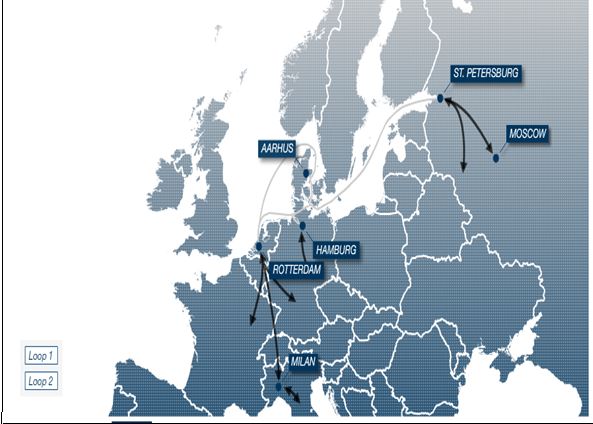Chapter 1
Introduction to Transportation System
Overview
The last decades have witnessed an increasing level of industrialization and liberalization of the world economy, which in turn has led a remarkable rate of growth in container transportation. Accompanied by an ever-increasing speed requirements and rising expectation of the customers, the international container operators are now facing very complex as well as a dynamic transportation system, which encompasses ocean-going services, transportation services on land etc. (Parragh and et.al., 2008). For the purpose of maintaining and sustaining in this highly competitive market, companies operating in the maritime industry are compelled to make improvements in their efficiency and they are also required to reduce their costs (Drexl, 2012).
The case company is a privately owned short sea container line, which was coming into existence in the year 2004 (About Delta Shipping Lines, 2013). The firm provides door to door and quay-quay container shipments “to and from” to Russia to Europe and vice-versa. They use modern ice classed glass vessels and an assortment of different types of containers. Here is the rote of voyages of Delta Shipping Lines:

Route of Delta Shipping Lines Company
Structure of the Research
The structure of the present research is as follows:
- Introduction – This is the very first chapter of the dissertation and provides a complete view of the topic being selected. Further, the introduction section of the report all uncovers various aspects like, the importance of the present research, framework & analysis and purpose of carrying out the study.
- Literature Review – This is the chapter, which provides theoretical knowledge in regards to the topic of the study. Various books, articles and journals related to the subject are being explored under this section.
- Research Methodology – Research methodology chapter is also vital, as it offers an assortment of methods being adopted by the researcher in order to carry out the successful research study.
- Data Analysis & Findings – Here, in this part of the dissertation, the data being gathered is analyzed in order to interpret the result.
- Conclusions & Recommendations – This is the concluding chapter of the dissertation. It entails various conclusions being drawn from the study and involves a range of recommendations, which might be useful for the firm to improve the level of performance.
Focus and Purpose of Research
- Focus: The main focus area of the research is empty container's management. Empty container's management is a very extensive topic and it is not feasible to explore each and every aspect of it.
- Purpose: There are many researchers and scholars who have carried out a number of research works on empty container management and its importance for the shipping organizations. Further, many research works of renowned authors have revealed that the global expense in regards with the repositioning of empty containers was amounted to around $ 30.3 billion in the year 2009 (Lam and et.al., 2007). This is considered as the substantial problem, as these costs account for 19 percent of the income of global maritime industry , and thus forms an important part in the cost structure of the industry.
Research Questions
In order to find solution for the problems and to carry out all inclusive research, it is important on the part of researcher to formulate some research questions and these are as follows:
- What is the significance of empty container management for Delta shipping company?
- What are the main actors and operations in intermodal door to door to services of Delta Shipping Lines Company?
- How the repositioning of empty containers is important for the firm?
- What are the approaches to reduce empty container repositioning costs?
- How a rationalizing empty container movement is vital?
Framework and Analysis
This is being regarded as one of the most important section of the dissertation, as it primarily helps in providing details about the steps in which the research will be conducted. Further, it also entails explaining in regards with various methodologies as well as strategies to be implemented by a researcher in the study (Holmberg and et.al., 1998). In addition to this, this part also offers a brief overview of the range of techniques i.e. data collection, sampling, analysis tools being adopted in the research. The analysis part is quite significant for the researcher, as it aids in determining the right path during the research study.
Potential Significance of Research
The present research report has both practical as well as academic relevance. First of all, the existing theories in relation to the empty container management and various models to reduce the costs of their repositioning is being studied under the organizational setting i.e. Delta Shipping Lines company. It is quite important for the companies to adapt as per the changing requirement and rising level of dynamism of the market (Notteboom, 2004). Speaking in regards with empty containers, it is quite essential for the firms manage these in order to earn more revenue. Generally, it refers to the flow of empty containers from one place to another.
Chapter-2
Introduction To Literature Review
In the middle of the 1960s, the influx of maritime container has led to an improvement of freight transport in numerous respects. It was becoming quite easy to transfer products from one place to another. Further, the use of containers has also paved the way for intermodal transport development. When articulating in relation with the present scenario, the maritime containers control the shipping industry and meanwhile, the extent of its impacts in land transport is also substantial (Managing Empty Containers, 2004). One of the significant shortcomings of containerization is that the place where the containers are often loaded and unloaded is not the same and thus, the movement of empty containers cannot be avoided.
Empty container management
Throwing light on the term empty container management, it is nothing but related to handling the movements, distribution and storage of empty containers. The repositioning or movement of empty container management starts just after the container is unloaded at the receiver’s location (Boil´e, 2006). Further, it comes to an end with the supply of empty containers at a super location, where these containers are required to be loaded again. Thus, it can be well attributed that the main goal of managing empty containers is to provide transportation of these containers at minimal costs and at maximum containers use.
Main actors and operations in intermodal door to door services
Throwing light on the intermodal door to door services, it is being defined as a transportation chain from a shipper to a receiver. Thus, it can be said that inter-modality is considered as one of the most important feature of a transport system, which allows at least two modes i.e. rail, water or road to be used in a door-to-door transport chain on an effective and integrated manner.
Empty containers repositioning
For each and every shipping company, the logistics in regards with the empty containers is the major issue. The repositioning of empty containers aims to transmit the containers to any export point, by quantity, time required, type and lastly, at minimal cost. As the shipping and logistic company are being involved in transporting the products by sea route, they have hundreds of containers in order to serve thousands of ports and the cost associated with these empty containers also reach hundreds of million dollars on an annual basis. This is quite a large amount and all firms are suffering from this issue (Rodrigue, 2013).
Importance of empty containers repositioning
Speaking in volume in regards with the container, it is nothing but a transport and the production unit, which can be moved as an import, export and repositioning flow. As the containers reached to the desired location, they are unloaded. Soon after this, the shipping companies must find another transport leg, as movement of empty containers is very costly as compared to moving the fully loaded containers (Empty Containers Repositioning, 2013). Shipping and maritime firms require containers in order to maintain their operations as well as the level of services Shipping organizations need containers to maintain their operations and level of service along the port network they call.
Assess the significance of rationalizing empty container movements
Empty container movement is the very costly process and also increases the expenses of the company. This is one of the most critical issues; transportation of these empty containers does not create any revenues for the organization but carry a cost of transportation. It is not only the cost but the empty container movement also requires resources and storage space. Around 6-7% of maritime income is wasted in the positioning of these empty containers (Braekers, Janssens and et.al., 2011).
Determining the ways of reducing empty container repositioning costs
Cost reduction with the empty container management is very necessary. There are various approaches by which aims at minimizing the usage of empty container movement in the sea or in the coastal areas are as follows:
- Intermodal Door to Door services : Transportation system is defined as the medium which helps in the movement of goods from one source to another, thus here the transportation of empty containers is defined as the movement of the empty containers in the present as well as the future customers.
- Hinterland Container Transportation : Here the two main problems is allocated; firstly it’s the container allocation and the vehicle positioning. There was a need of the management of the empty container management and the vehicle positioning
- Container Sharing : there are some more ways of reducing the transportation cost which was not reduced in hinterland transportation, one of which was as through container sharing.
Chapter-3
Introduction To Research Methodology
Research Methodology is a very important part of the research as compared to the other areas. It makes use of all available data and relevant theories and helps an organization to generate findings in the area where research is commenced. Research initiates with the help of various strategies; these strategies are further discussed in this section of the dissertation (Walton, n.d). The main aim of writing research methodology is to find out how the research is commenced and what the limitations of the research are. It also provides a guide map to fulfil all aims and objectives. It also provides various data which helps the researcher to complete the dissertation.
Aims & Objectives of the Research
Aim – To main aim of the research is to analyze the need of empty container management to minimize the costs associated with repositioning of empty containers in an organizational setting Delta Shipping Lines Company.
Objectives – In order to realize the above stated aim, the following objectives need to be attained first and these are as follows:
- To understand the concept and significance of empty container management for Delta Shipping company
- To determine the main actors and operations in intermodal door to door to services of Delta Shipping Lines company
- To evaluate the importance of empty container repositioning for company
- To determine the ways of reducing empty container repositioning costs
Research Philosophy
Research philosophy is the idea on which the whole research is proposed. It is a specific pattern of investigation, which is recognized by the research philosophy. Research Philosophy is very important as all the other attributes of this section are dependent on the philosophy. There are basically two types of philosophies, i.e. positivism and interpretivism. Both these are equally accountable for a better research. When a survey is performed positivism is a relevant philosophy (Williams, 2011).
Research Design
When it comes to the dissertation, design of a research plays a very important role, as it provides the researcher a guide map of how to perform a dissertation. It is very important as it helps the researcher in the collection of data and then using the appropriate styles for analyzing. Research design is classified into various types; these are as exploratory, descriptive and casual. Causal design aims at identifying the variables, of which some results will be interpreted in the future.
Research Approach
Research approach is basically of two types one is Inductive and the other one is Deductive. Inductive approach begins with the collection of authentic data, further with observation and later examining various patterns, and finally a theory is proposed with respect to the selected topic. It is said that researchers move to a general conclusion from specific conclusions (Hannabuss, 2007).
Research Type
Research type is the category in which research will be classified, research is basically of three types it can either be qualitative, quantitative or it can be a case study. Quantitative research is aimed to generate true results with the help of some numerical calculations and statistics (Qualitative research methods, n.d). It basically concentrates on the discussions and interviews as the data collected helps to perform the quantitative analysis.
Data Collection methods
Data as stated is of primary or secondary type, collection of data is a very hectic and critical task. Primary data can be collected by various ways such as observation, survey, focus group, interviews etc. This primary data is very worthy and helps the researcher in various findings. Secondary data are said to be the already available data which are collected through various secondary sources like the books, journals, newspaper articles and already available sources (Crowther and et.al., 2012). This secondary data is the biggest support for primary research; final findings must be based on a three way assumption, i.e. primary, secondary and the researchers point of view.
Sampling
Sampling is the used by researcher to select data for analysis out of all the available data, to compile the primary research. The various ways, by which a researcher selects data through sampling, it may be a random sampling, stratified sampling, systematic sampling, multistage sampling, judgment sampling, purposive sampling etc. (Gardner, 2004).
Data Analysis
After the collection of data and selecting the final data for evaluating the researcher has to finally analyze the available data and then bring out some necessary outcomes. With the data analysis the researcher comes to know whether the obtained results have fulfilled all aims and objectives are not (Glenn and et.al., 2005). Data analysis is categorized on the basis of quality and quantity. Quantitative data analysis gives outcomes in the form of numbers whereas qualitative data analysis outcomes are in those areas where the quantitative analysis does not work.
Validity and Reliability
Validity and reliability are very vital aspect of a research, the validity of the collected data is very important. The researcher has to keep in mind that the data collected is appropriate and can be considered for the dissertation. One has to ensure the validity of data as outcomes are completely depended on the valid data. Analysis of valid data helps the researcher to commence this dissertation in proper sequence.
Research Limitations
There are some limitations which are being faced by the researcher in the present dissertation these are as follows:
- Prolonged Process – The research process is very time consuming, data collected from primary as well as secondary sources is very difficult and also consumed time. Apart from this prolonged process there were a time limit and deadlines were to be met strictly
- Inadequate Secondary Data – Research majorly depends on the Secondary Data, but the available secondary data does not complete the whole dissertations, thus here the researcher has also collected primary data.
Student may also like to read:Understanding Change Management | Toyota
Ethical Considerations
There are various ethical considerations which researcher has followed while preparing this dissertation, these are as follows:
- Privacy and Secrecy – The biggest and the most ethical consideration of the research process is secrecy, in a research people are reluctant to participate in a research because they are scared of their information being leaked out.
- Seeking prior Permission – a researcher before involving participants in their research must take prior permission of these participants (Glesne, 2005).
- Plagiarism Free – When a researcher collects secondary data, one has to ensure that it is not copied directly from the source without proper referencing. This copied data is unauthorized; here the researcher has avoided copying.
Chapter 4
Introduction To Data Analysis And Findings
With the data analysis the researcher comes to know whether the obtained results have fulfilled all aims and objectives or not. Data analysis is categorized on the basis of quality and quantity. Quantitative data analysis gives outcomes in the form of numbers whereas qualitative data analysis outcomes are in those areas where the quantitative analysis does not work.
Thematic Analysis
Theme 1: Cost and Unorganization Increasing the Need of Empty Container Management._566a6e2634fb9.jpg)
Need of Empty Containers (Managers Survey)
Theme 2: Intermodal Door to Door services and Hinterland Container Transportation assumed to be the best possible solutions for Delta Shipping Lines:
Here was the survey performed which clearly stated the strategies adopted by the Delta Shipping Lines company for their empty container management, these are as follows:
_566a6f0ced85f.jpg)
Strategies Adopted (Managers Survey)
Theme 3: Efficiency of strategies adopted for empty container management:
_566a6ff7b764a.jpg)
Effectiveness of Strategies (Managers Survey)
Cost Calculation
Quantitative Analysis
Here is some Information about the Delta Shipping Lines Company:
- Turnover of dry container is 60 days and refrigerated container is 45 days.
- Most of the Containers are in Long term Leasing.
Import Rent to be paid by Customers
Dry containers Eastbound (inbound) First 10 calendar days are free, onward charges are as follows:
- 20' 7 days: EUR 15, -/Cntr/day, thereafter: EUR 20, -/Cntr/day
- 40' 7 day : EUR 20, -/Cntr/day, thereafter: EUR 30, -/Cntr/day
Reefer containers
First 7 calendar days are free, onward charges are as follows:
- 20' reefer 7 days: EUR 30, -/Cntr/day thereafter: EUR 50, -/Cntr/day
- 40' reefer 7 days: EUR 40, -/Cntr/day thereafter: EUR 70, -/Cntr/day
Chapter 5
Conclusion And Recommendation
Conclusion
Globalization of the world economy has allowed companies to trade across borders and Industrialization has led to rapid industrial development. Large amount of shipments has supported enormously by shipping companies. Due to increased traffic in the container transportation, shipping companies have to affront a complex transportation system at sea ports and hinterland (Fagerholt, 1999). Companies apart from managing this heavy traffic spend large amounts of money on the container management.
Recommendations
Increased cost and the problems arising due to mismanagement are the major reason, which raises the demand for the generating empty container management. Here the company has opted Hinterland Container Transportation and also Intermodal door to door, here they have created a model where they have shipments through three ports.
Student may also like to read: Banqueting Management - Service On A Plate
Chapter 6
Reflective Statement
Introduction
The compilation of this dissertation was a very significant journey in my curriculum, where I built in myself the skill of independent learning. However most of the time commencement of dissertation became challenging for me. The above research report gave me an immense knowledge of various techniques adopted by adopted by different companies for the empty container management.
There were many issues and challenges which I came across while commencing this whole research process but due to proper guidance I was able to manage these issues. Thus, it can be accredited that this complete dissertation has given a great support in raising my knowledge and also increased my confidence level. Now I feel that this dissertation has efficiently completed the educational stage and I am looking ahead to build a dazzling scenario in future.
References
Books and Journals
- Barber, D. and et.al., 2001. Implementing a Statewide Goods Movement Strategyand Performance Measurement of Goods Movement in California. METRANSTransportation Center.
- Barber, D. and et.al., 2001. Implementing a Statewide Goods Movement Strategy and Performance Measurement of Goods Movement in California. METRANS Transportation Center.
- Boil´e, M., 2006. Empty Intermodal Container Management. New Jersey: Department of Transportation.
- Boile, M. and et. al., 2008. Regional Repositioning of Empty Containers: a Case for Inland Depots. Proceedings of 87th Transportation Research Board Annual Meeting. pp.31-40.


























